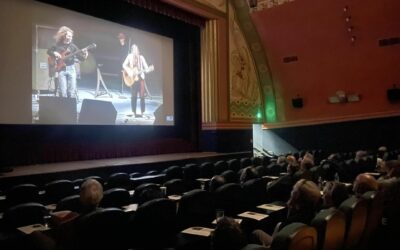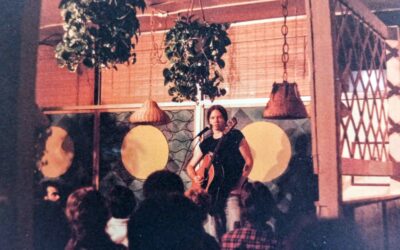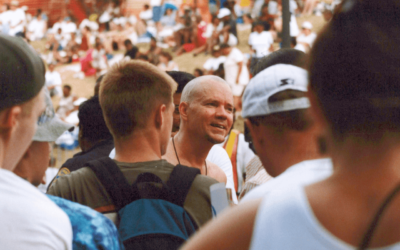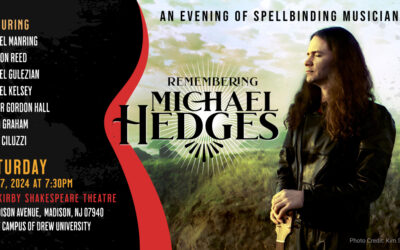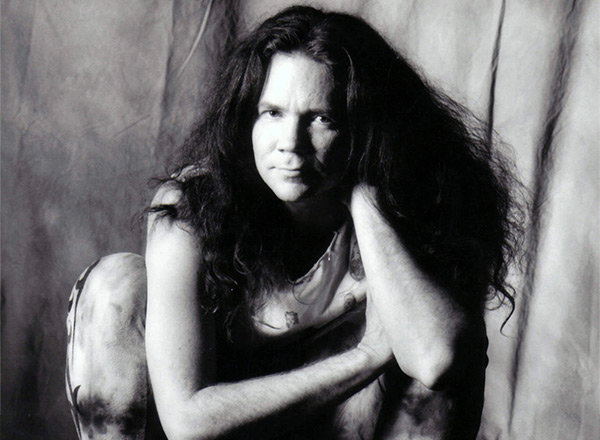From the original Nomadland.com website.
By Matt Guthrie
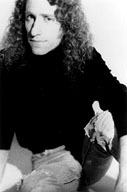
Michael Manring
Since the two began their recording careers together on Breakfast in the Field [Manring was just 20 at the time], it seems like Manring has recorded with, toured with, or jammed with absolutely everyone in absolutely every style, from the shred of Gary Hoey to the raga of Will Ackerman to the savage funk of Alex Skolnick. But 1994 was definitely Manring’s year. He was voted “Bassist of the Year” in Bass Player and his radical departure into “new-age-grunge-thrash-fusion” on his fourth solo album Thonk left no doubt that if California ever does slide into the Pacific it’ll be his fault (pun definitely intended).
If you want to check out some of Manring’s solo bass work and get a Hedges goodie at the same time, check out the Windham Hill Guitar Sampler v. II. It has Hedges’ otherwise unreleased instrumental arrangement (with Manring) of George Harrison’s “If I Needed Someone”, but the real star of the collection (in addition to “Ritual Dance” of course) is the first of two bass solos by Manring titled “Selene”. As with “Aerial Boundaries”, “Selene” has an awe-inspiring depth and emotion, mind-blowing array of sounds from one instrument, and a sort of omni-cultural feel which puts it firmly in my top ten list of most amazing pieces of music.
I first met Manring while playing with Hedges in Cincinnati in ’94 (interview below). It occurred to me that when he said of being a professional musician, “You gotta be into it”, he had all the right props—he was sitting cross-legged in his bass case while warming up.
— Matt
Interview with Michael Manring, 4/15/94
Soooooo, when did you and Michael first meet?
In 1979. A friend and I were playing a jazz gig in Baltimore and Michael was there. I think he may have been lending us all or part of the sound system. It was a pretty nice gig. Kind of a supper club place, but we could play whatever we wanted and I got to do some of my solo pieces. Michael saw me goofing around with the same sort of stuff he was playing on guitar so he came up to me after the gig and said, “Hey, we gotta hang out!” And I thought, “Who is this guy?” [Laughs.] But my friend said Michael was a really good guitarist and that I ought to try playing with him and see how it goes. It wasn’t too long after that, maybe a month or so, that we made the first demo for Windham Hill.
For the demo we did “Two Days Old” and “Baby Toes” pretty much as they appear on Breakfast in the Field. I think it also had “Transience”, “Watching My Life Go By”, “Vital Signs”…
The Rush song?!
[Laughs] No, it’s one of Michael’s. We should do a Rush song though!
You should do that one. Geddy’s part is seriously hip. You could really go places with it.
Yeah! He’s so amazing. That’s a pretty quirky and groovy tune.
Let’s see…oh yeah, we also did “Holiday”. Maybe a few others of Michael’s too. I’m not exactly sure what he sent to Windham Hill. I think it was “Two Days Old”, “Baby Toes”, and a few solo pieces. I guess it was 1981 before I finally flew out to California and we recorded Breakfast in the Field.
Do you guys still work out ideas together?
Sometimes. We did a ton in the early days because we toured so much together. We even went to Japan together. Lots of gigs all over. Yeah…me, Michael and “Big Jim” [laughs].
Who?
Big Jim was Michael’s orange Volkswagen van. We put in a lot of time and miles in Big Jim. We used to be able to shift drivers without stopping. Michael taught me how to drive a stick in Big Jim. We usually slept in Big Jim. I would fly out to California and we’d go on the road. We played a lot at the New Varsity Theater in Palo Alto and people would come and sit in.
Were you playing with Michael at the New Varsity when Will Ackerman first saw him?
No. Michael had already met Will. But everybody used to show up when we were playing there. Darol Angor and Mike Marshall would come and sit in with us all the time.
Had they left David Grisman’s band by then?
Yeah, they had just left and were kinda goofin’ around. We actually had a band for a while. We did a few tours together as “Darol & The Mikes” [laughs]. Just the four of us playing everybody’s music. Really bizarre. We even played jazz tunes…these sort of “in-your-face” Charlie Parker covers.
In your cover story interview in Bass Player [February ’94] you say you feel you and Michael share a “common musical vision”. How would you characterize that?
Well, the first thing we did after meeting was to just talk about music and we immediately realized there was a lot of common ground. In the space of a few minutes we were talking about Morton Feldman, AC/DC, Led Zeppelin, Miles Davis, Neil Young, etc., and how much we both enjoy all that music. I guess we’re always trying to see what’s out there, goofing around and finding out what kind of trouble we can get into on that front, yet always trying to keep it musical. So I would say those kind of things. An appreciation of lots of different types of music for lots of different reasons and an interest in sort of the outer limits. But a primary interest in musical expression that’s really human.
How do you keep the music fresh while working with roughly the same set list for a whole tour?
Michael’s miraculous at that. The guy is unbelievable. Just unbelievable. He plays every song different every night. And it’s always fresh. He always has a new way of looking at things. He’s definitely a huge inspiration for me. Always listening.
People often ask, “When you’re doing these pieces which are all through-composed is there time for improvisation?” I think that’s really assuming a very limited view of improvisation. There’s this assumption that improvisation is either to open up the tune and blow over the changes or do a Grateful Dead jam. But there are a lot more ways to improvise, and Michael is brilliant at finding new ways to look at music every night—new ways of dealing with dynamics, phrasing, articulation, tone, tempo, sometimes the arrangement of the piece. Everything.
We didn’t used to have set lists. In the old days before there was a crew, we’d just go out and start playing. We might get halfway through a song and start going into something else or start going off into…whatever, not really knowing where we were going to end up. It used to happen a lot…and it’s been happening a lot more recently [laughs]. A few nights ago in East Lansing one of the vocal tunes suddenly became reggae so we jammed it out for awhile [laughs].
So there are lots of different ways to look at the music. Michael’s real good at finding new ways to look at all kinds of things. When you think about it, that’s what creativity is really all about. It’s not really about extending some line that’s already been established. It’s about learning to look at something in a new way. Often something that’s right there in front of you. New perspectives. And you know, sometimes it doesn’t work [laughs]. But the important thing is to find out.
What’s the stage contact like between you and Michael?
It’s pretty intense actually. It’s interesting because that’s always been there. As I say, Michael’s constantly searching for the mode of the piece…and I just always know where he’s going. I’m really not sure how or why. I can just hear where he’s going. Sometimes we don’t always land in the same place, but to me it’s amazing. I play with a lot of people and I don’t have that kind of connection with them. Maybe with my brother because we’ve been playing together all my life. I think Michael and I just have a similar idea about what we’re trying to accomplish. It’s a pretty amazing experience.
Would you say that kind of communication is what music’s all about?
I think so. It’s a certain type of communication that you search for that you couldn’t do with language. I always wonder how much people pick up on that when we play because it’s pretty deep. Sometimes we’ll start a phrase together and we’ll have a dynamic shape that we both kind of just do. Not rehearsed or anything. It may be only five notes in a phrase but we’ll just know what the shape is going to be. I wonder if people can actually hear to that degree—just hear that something’s going on.
I think Frank Zappa estimated 2% of the audience are really in the zone and feeling all the nuances.
Yeah, that’s probably right. Like I say, what goes on between us when we play always surprises me. When I play with someone else for a long time and feel like we’re really tight and then go play with Michael, we won’t even rehearse or anything. We’ll just go out on dates and start playing. It’s like going from this level [hand at waist] to this level [hand above head].
How would you differentiate your instruments and relate them to your personalities?
I guess to us they’re sibling instruments. Related but with clear differences. I think the differences are definitely reflected in our personalities. I think Michael’s a lot more outgoing than I am…which isn’t saying much [laughs]. [Listen to Thonk before you take this at face value.] For us, these are sort of the instruments of the day—the instruments where everything’s happening. The violin had its day probably a hundred years ago. People really fell in love with it. Both listeners and players. In the West, it was certainly explored and experimented with to a very high degree in the sense that I think it really earned its mature voice in the West. I think that’s happening now with our instruments. With bass certainly it’s just beginning to happen.
When you think of what Michael’s done, he’s basically…well, I mean there certainly was a tradition of solo acoustic guitar music before he came along, but he’s really expanded the stakes. He’s made it a much broader art form. That’s what’s exciting about these instruments—that for us they really say something about our culture right now. Hopefully, we’re able to experiment with them and use them as vehicles for a sense of pioneering and expression that reflects what’s happening in our culture.
When you think about it, Michael’s acoustic guitar playing is very electric. He’s one of the few acoustic guitarists…actually he’s the only one I can think of who always performs without a microphone. And it sounds awesome. That used to be thought of as the cheap way to go. Now suddenly you find guitarists all over adding pickups to their acoustics instead of microphones. So his approach is very electric and I think that’s part of the whole picture. What’s happening with electronics is a big part of our age, and yet trying to stay human in that context is an important message, I think.
Considering how many musicians you work with—and how frequently you do—how do you maintain your energy while on tour?
It gets really hard, as you know. It’s tough being away from home for so long. You can go a week without really getting any sleep and you may only eat a decent meal every other day. You find yourself paring life down to its basic necessities. It’s interesting because it forces you to play what you really need for your heart, what you really need for your soul. It’s an interesting lifestyle. It kind of burns away all the junk in your life and you’re left with just you. I mean, when you’re at a point of physical exhaustion, you ask yourself, “Do I really need to go on with this?”
Recently, I was in Europe by myself, working really hard, and did one of these things where…let’s see…I played a gig in Holland and after the gig drove to Amsterdam, got about four hours sleep, drove to France, got out and played a gig, had a meal, took a train to Paris, took a cab out to Charles de Gaulle airport, my flight was canceled so I took a bus across town to Orly, flew to Chicago, flew home to California, and then had to go directly to a gig with John Gorka. I had basically been up for three or four days. I wasn’t making very much money and hadn’t eaten very well. So you find yourself really pushed to the limit, asking, “Is this really worth it? This is ridiculous! What am I doing here and why?” But as I say, in a way, that’s good because it gets rid of everything that’s not important in your life. You start to think more of what you really need and the things that you really have to do. You gotta be into it.
[At this point, Hedges’ tour manager at the time, Chip White, walks in and sits down. Chip is renown as a surreal and sadistic word-player. And that afternoon was no exception…]
Chip: If you had a bunch of women around you that were call girls and you ran a phone referral service for them, would that be a “pro-call harem”?
Manring: Hmmmmmm…I’m glad the tour’s almost over.
[Having thus proven that customs agents, jet lag, and malnutrition are no match for Chip’s jokes, this seemed like an excellent time to stop the interview.]
Release Party & Screening – The Artist’s Profile: Michael Hedges
On April 30, 2024, Michael’s family and filmmaker Brian Malone hosted a special pre-release party & screening of the 1998 documentary, “The Artist’s Profile: Michael Hedges.”
“I’m Your Guitarist” (Robert Sorrenti)
I met Michael in December 1984. He had been scheduled to play at my small restaurant in Tallahassee Florida about a year earlier with Scott Cossu but had missed the plane.
25 Years Since We Lost Michael
It’s been 25 years since we lost Michael. Not a day goes by that we don’t think of him. Here’s an update on the projects we’re working on to celebrate his life and music.
